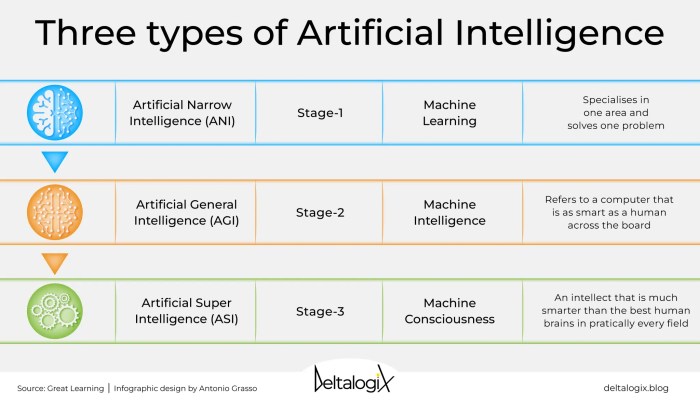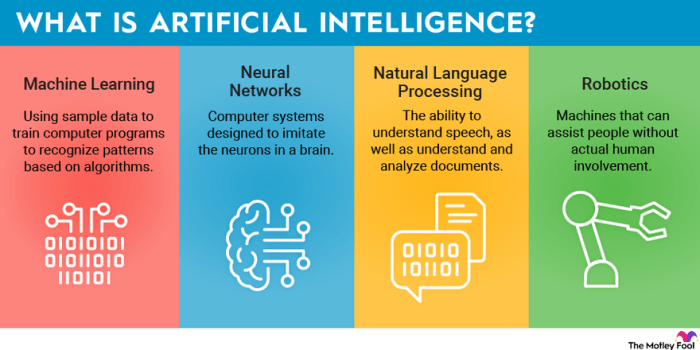Embark on a journey through the levels of artificial intelligence with this detailed guide. From Artificial Narrow Intelligence to Artificial Superintelligence, explore the evolution of AI capabilities and their impact on society.
Learn about the different stages of AI development, from basic automation to advanced cognitive functions, and discover how each level paves the way for new possibilities and challenges in the field.
Understanding Artificial Intelligence Levels

Artificial Intelligence (AI) is categorized into different levels based on its capabilities and functionalities. These levels represent the progression of AI technology from basic to advanced systems.
Level 1: Reactive Machines
Reactive Machines are the most basic form of AI that can only react to specific situations. They lack memory and cannot use past experiences to make decisions. An example of this level is IBM's Deep Blue, a chess-playing computer.
Level 2: Limited Memory
AI systems at this level can store past experiences to make decisions in the present. They can learn from historical data but still require human intervention. An example is self-driving cars that use sensors to navigate roads based on stored information.
Level 3: Theory of Mind
This level involves AI systems that can understand human emotions, beliefs, intentions, and thought processes. They can anticipate human behavior and interact more naturally. Virtual assistants like Siri and Alexa are examples of this level.
Level 4: Self-Awareness
AI systems at this level have self-awareness and consciousness. They can understand their own existence, emotions, and thoughts. While theoretical at the moment, this level represents the pinnacle of AI development.
Level 1: Artificial Narrow Intelligence (ANI)

Artificial Narrow Intelligence (ANI) refers to AI systems that are designed for specific tasks and have a narrow range of abilities. These systems are focused on performing a single task or a limited set of tasks, unlike general AI systems that can understand and perform a wide range of tasks.
Characteristics of ANI:
- ANI is task-specific and can only perform predefined tasks.
- It lacks the ability to generalize beyond the specific tasks it is designed for.
- ANI requires large amounts of data and specific instructions to operate effectively.
- These systems are not capable of learning or adapting to new situations without human intervention.
Real-World Applications of ANI:
- Virtual personal assistants like Siri, Alexa, and Google Assistant.
- Recommendation systems used by online platforms such as Netflix, Amazon, and Spotify.
- Natural Language Processing (NLP) tools for language translation and sentiment analysis.
- Autonomous vehicles that operate within a defined environment, such as self-driving cars.
Limitations of ANI:
- ANI is limited to the specific tasks it is designed for and cannot adapt to new tasks or situations.
- These systems lack the ability to understand context or make connections between different tasks.
- ANI relies heavily on human input and supervision to function effectively.
- There is a risk of errors or inaccuracies when ANI is used outside of its intended scope.
Level 2: Artificial General Intelligence (AGI)
Artificial General Intelligence (AGI) refers to a type of artificial intelligence that possesses the ability to understand, learn, and apply knowledge in a manner similar to human intelligence. Unlike Artificial Narrow Intelligence (ANI), which is designed for specific tasks, AGI aims to mimic the broad cognitive abilities of humans across a variety of domains.
Human-like Intelligence in AGI
AGI seeks to replicate human-like intelligence by enabling machines to reason, plan, solve problems, and adapt to new situations in a way that goes beyond predefined tasks
- AGI systems are expected to exhibit self-awareness, consciousness, and the capacity for complex decision-making based on ethical considerations.
- These systems should be able to understand natural language, engage in meaningful conversations, and demonstrate a deep understanding of context.
- AGI also involves the ability to transfer knowledge from one domain to another, generalize learning, and apply skills in novel situations.
Ongoing Research and Projects
Research and projects related to achieving AGI are actively pursued by various organizations and institutions around the world. Some notable examples include:
- OpenAI: OpenAI is a research organization dedicated to developing artificial general intelligence in a safe and beneficial manner. Their work focuses on creating advanced AI systems with human-level capabilities.
- DeepMind: DeepMind, a subsidiary of Alphabet Inc., is known for its research in artificial intelligence and machine learning. They are working towards developing AGI through cutting-edge research and innovative algorithms.
- SingularityNET: SingularityNET is a decentralized AI platform that aims to create a global network of AI agents capable of sharing knowledge and collaborating on tasks. Their goal is to advance the development of AGI through collaborative efforts.
Level 3: Artificial Superintelligence (ASI)
Artificial Superintelligence (ASI) refers to a hypothetical level of artificial intelligence that surpasses human intelligence in every aspect. ASI would possess cognitive abilities far beyond that of humans and could potentially solve complex problems, make decisions, and innovate at a level incomprehensible to us.
Capabilities of ASI
- ASI would have the ability to learn and adapt at an exponential rate, far surpassing human capabilities.
- It could potentially possess superhuman levels of creativity, problem-solving skills, and decision-making abilities.
- ASI might have a deep understanding of various fields of knowledge simultaneously, leading to groundbreaking discoveries and advancements.
- It could potentially revolutionize various industries, leading to unprecedented progress and innovation.
Implications of Achieving ASI
- The development of ASI could lead to significant societal changes, impacting employment, economics, and even the very fabric of our society.
- ASI's immense capabilities could potentially solve complex global issues such as climate change, disease eradication, and resource management.
- There are concerns about the control and ethical implications of ASI, as its decision-making processes may be incomprehensible to humans.
- The emergence of ASI could lead to a paradigm shift in how we perceive intelligence and our place in the world.
Ethical Considerations Surrounding ASI Development
- There are ethical concerns regarding the potential misuse of ASI for malicious purposes, leading to unintended consequences and harm.
- Questions arise about the moral responsibility of creating entities with superhuman intelligence and the implications of their actions on society.
- Ensuring the alignment of ASI's goals with human values and ethics is crucial to prevent any adverse outcomes or conflicts.
- Ethical frameworks and regulations need to be established to guide the development and deployment of ASI responsibly and ethically.
Closure
In conclusion, the levels of artificial intelligence offer a glimpse into the future of technology and innovation. As we continue to push the boundaries of AI capabilities, it becomes imperative to consider the ethical implications and societal impact of these advancements.
Stay informed and engaged as we journey towards a future shaped by artificial intelligence.
FAQ Insights
What are the different levels of artificial intelligence?
The levels of artificial intelligence range from Artificial Narrow Intelligence (ANI) to Artificial Superintelligence (ASI), each representing a different degree of cognitive abilities and autonomy.
How does Artificial General Intelligence (AGI) differ from ANI?
AGI possesses human-like intelligence and the ability to understand and learn from experiences, unlike ANI which is limited to specific tasks.
What are some real-world applications of Artificial Narrow Intelligence (ANI)?
ANI is commonly used in applications like virtual assistants, recommendation systems, and autonomous vehicles due to its ability to perform specific tasks efficiently.
What ethical considerations are associated with the development of Artificial Superintelligence (ASI)?
The development of ASI raises concerns about control, safety, and the potential consequences of creating an intelligence that surpasses human capabilities.


